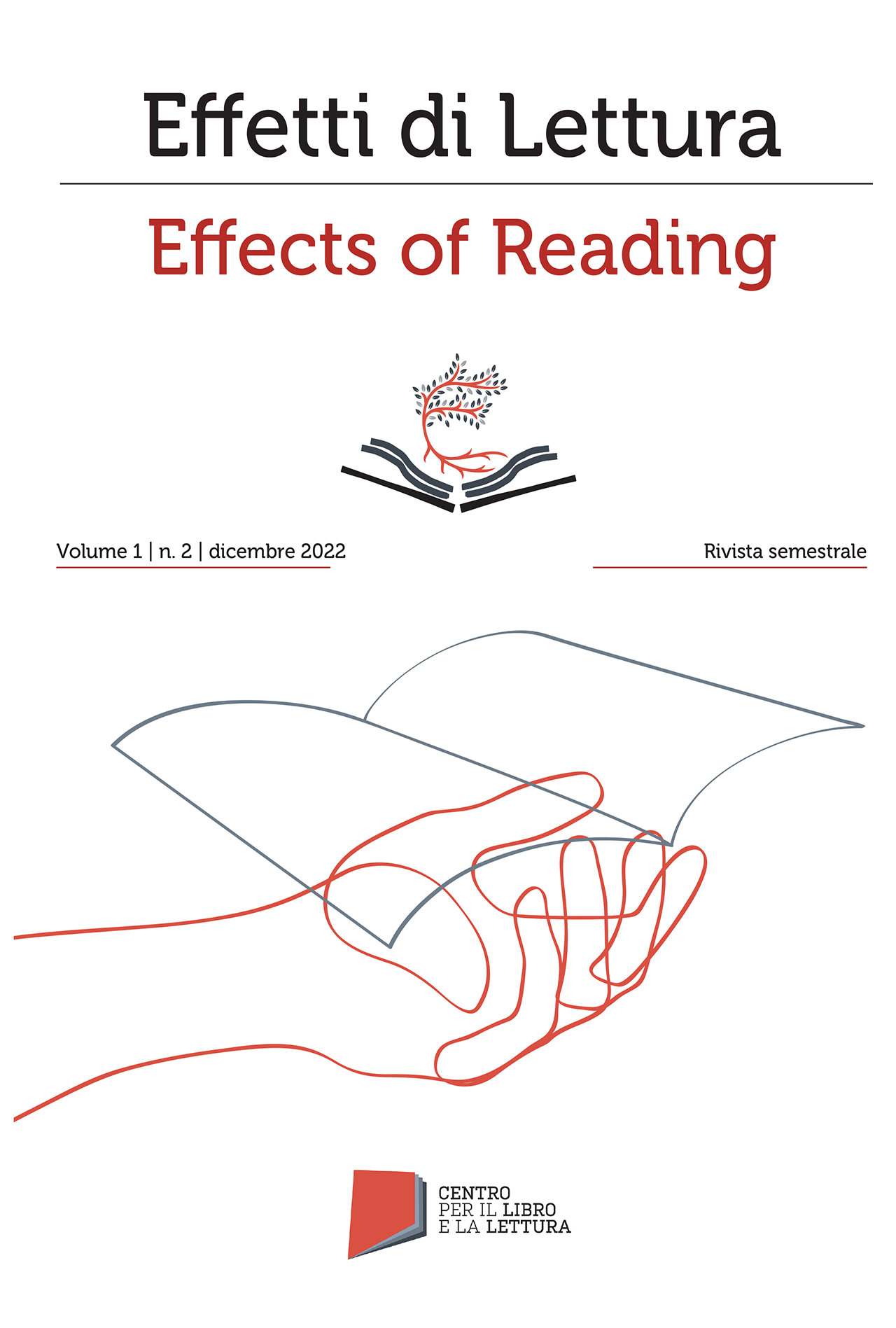Lettura: sostantivo femminile?
DOI:
https://doi.org/10.7347/EdL-02-2022-03Parole chiave:
Lettura, iconografia, immagini, divario di genere, modelli di lettoreAbstract
Basandosi su alcune ricerche internazionali che sottolineano l’importanza di presentare modelli maschili di lettori per incoraggiare i ragazzi a leggere, il contributo presenta uno studio esplorativo sui modelli di lettori nella pittura e nella letteratura. Attraverso una ricerca web tra siti che collegano lettura e pittura, sono stati analizzati circa 250 dipinti raffiguranti uomini e donne intenti alla lettura. L’obiettivo era osservare la frequenza delle presenze femminili e maschili, analizzare i modi in cui sono ritratti ed eventuali differenze. Infine, sono stati selezionati alcuni famosi testi della letteratura per ragazzi che contengono personaggi che leggono e sono stati esaminati i modi in cui lettrici e lettori sono rappresentati. Nei limiti del campione, i risultati mostrano una tendenza a rappresentare più lettrici donne o ragazze. Inoltre, nella rappresentazione, le caratteristiche attribuite alla lettura maschile e femminile cambiano: la lettura femminile è principalmente legata al tema del piacere e alla ricerca della propria identità, mentre la lettura maschile è più associata allo studio e all’acquisizione di informazioni. In studi futuri, sarebbe interessante capire se queste diverse rappresentazioni influenzano la relazione dei ragazzi e delle ragazze con la lettura.
Downloads
Riferimenti bibliografici
Agamben, G. (2008). Signatura rerum: sul metodo. Torino: Bollati Boringhieri.
Antoniazzi A. (2009). Allarme rosa. Intervista a Emy Beseghi. LiBeR, 82
Bodei, R. (1979). Comprendere, modificarsi. Modelli e prospettive di razionalità trasformatrice. In Gargani A. (Ed.), Crisi della Ragione. Torino: Einaudi.
Bichi, R. (2002). L’intervista biografica. Milano: Vita e Pensiero.
Bollmann, S. & Heidenreich, E. (2005/2007). Frauen, die lesen, sind gefährlich [Le donne che leggono sono pericolose]. Milano: Rizzoli
Cipolla, C.M. (2002). Istruzione e sviluppo: il declino dell'analfabetismo nel mondo occidentale. Bologna: Il Mulino.
Clark, C. (2009). Why fathers matter to their children literacy. Retrieved November 25, 2019, from: http://www.literacytrust.org.uk .
Clark, C., & Picton, I. (2012). Family matters: the importance of family support for young people's reading. Retrieved January 18, 2019, from: http://www.literacytrust.org.uk .
Clark, C. (2012). Boys' Reading Commission 2012: A Review of Existing Research Conducted to Underpin the Commission. January 20, 2019, from: http://www.literacytrust.org.uk.
EU, High level group of experts on literacy, (2012). Final report EU, Retrieved April 4, 2014 from http://www.ec.europa.eu
Eurostat, (2016). Cultural Statistic, DOI 10.2785/56811
Ferrante, A. (2017). Che cos’è un dispositivo? Milano: Franco Angeli.
Foucault, M. (1975/2011). Sorvegliare e punire: nascita della prigione. Torino: Einaudi.
Ginsburg, C. (1986). Miti, emblemi e spie. Einaudi: Torino.
Klüger, R. (1996). Frauen lesen anders: Essays, Monaco: Dtv.
Istat, (1966). Indagine speciale sulle letture in Italia. Retrieved December 5, 2019 from www.istat.it
Istat, (1989). Indagine multiscopo sulle famiglie. Retrieved December 5, 2019 from www.istat.it
Istat, (2011). Infanzia e vita quotidiana. Retrieved September 10, 2019 from www.istat.it
Istat, (2012). Indagine sull'uso del tempo. Retrieved September 18, 2019 from www.istat.it
Istat, (2019). Produzione e lettura di libri in Italia (anno 2018). Retrieved December 5, 2019 from http
Lyons, M. (1997/2009). I nuovi lettori del XIX secolo: donne, fanciulli, operai. In G. Cavallo & R. Chartier (Eds.), Storia della lettura nel mondo occidentale (pp. 371-410). Milano: Raffaello Cortina.
Marcialis P. (Ed.), (2015). Educare e ricercare. Oltre la fine della pedagogia nella cultura contemporanea. Milano: Franco Angeli.
Massa, R. (1987). Le tecniche e i corpi: verso una scienza dell'educazione. Milano: Unicopli.
Massa, R. (Ed.). (1992). La clinica della formazione: un'esperienza di ricerca. Milano: Franco Angeli.
National Literacy Trust (2012). Boys’ reading commission report. Retrieved January 25, 2019, from http://www.literacytrust.org.uk
OECD, (2015). OECD, (2015), The ABC of gender equality in education: Aptitude, behaviour, confidence, Paris: OECD Publishing.
OCSE, (2010) Pisa 2009 Results: overcoming social background, equity in learning opportunities and outcomes. Retrieved March 6, 2019, from http://www.oecd.org
Orsenigo, J. (2008). Lo spazio paradossale: esercizi di filosofia dell’educazione. Milano: Unicopli.
Schleicher, A. (2019). PISA 2018. Insight and Interpretation. Retrieved from www.oecd.org
UNESCO 2005, (10-12 June, 2003), Aspects of Literacy Assessment: Topics and issues from the UNESCO Expert Meeting. UNESCO. Pag.21. Paris.-Retrieved from: http://unesdoc.unesco.org
Woolf, V. (1929/2013). A Room of One's Own [Una stanza tutta per sé]. Milano: Feltrinelli.
##submission.downloads##
Pubblicato
Come citare
Fascicolo
Sezione
Licenza
Copyright (c) 2023 Effetti di lettura / Effects of reading

Questo lavoro è fornito con la licenza Creative Commons Attribuzione - Non commerciale 4.0 Internazionale.








